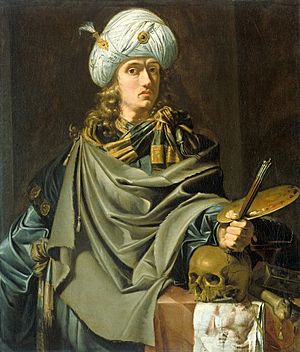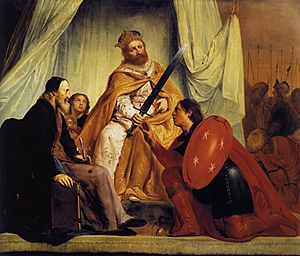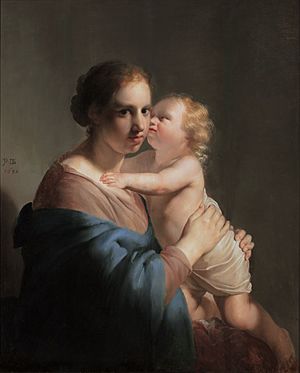Pieter de Grebber facts for kids
Pieter Fransz de Grebber (born around 1600, died 1652 or 1653) was a famous painter from the Dutch Golden Age. This was a time when Dutch art, science, and trade were very strong. Pieter de Grebber was known for his beautiful paintings, especially those showing stories from history or the Bible.
Contents
About Pieter de Grebber's Life
Pieter de Grebber was born in Haarlem, a city in the Netherlands. He was the oldest son of Frans Pietersz de Grebber, who was also a painter and made detailed embroidery. Pieter had two siblings, Maria and Albert, who also became painters.
Pieter learned how to paint from his father and from another well-known artist named Hendrick Goltzius. His family, the De Grebbers, had a long history of being artists and were Catholic. His sister Maria later became the mother-in-law of a famous painter named Gabriel Metsu. Pieter was also friends with a priest and music expert, Jan Albertszoon Ban. A composer from Haarlem, Cornelis Padbrué, even set one of Pieter's poems to music.
In 1632, Pieter became a member of the Haarlem Guild of St. Luke. This was an important group for artists and craftsmen. But he had already been painting professionally for about ten years before joining. Some of his students who later became artists included Nicolaes Pietersz Berchem and Egbert van Heemskerck.
Important Art Projects
In 1618, Pieter and his father traveled to Antwerp (a city in Belgium). There, they talked with the very famous painter Peter Paul Rubens about selling his painting called Daniel in the Lions Pit. This painting was then given to King Charles I of England through the English ambassador.
Pieter de Grebber received many important jobs, not just in Haarlem. He also got work from the stadholder Frederik Hendrik. A stadholder was like a governor or leader in the Dutch Republic. Pieter helped decorate grand buildings like the Huis Honselaarsdijk and the Paleis Noordeinde in The Hague. He also painted special altarpieces for churches in Flanders and for hidden Catholic churches in the Netherlands. He might have even worked for people in Denmark.
Pieter de Grebber never married. From 1634 until he died, he lived in the Haarlem Béguinage, which was a community for religious women and some single men.
Pieter de Grebber's Art Style
Pieter de Grebber painted many different kinds of art. He created history paintings, which are large pictures showing stories from the past, myths, or the Bible. He also painted many portraits (pictures of people). Besides paintings, many of his drawings and a few etchings (a type of print) still exist today.
His unique style was influenced by several art movements. He learned from the Utrecht Caravaggistis, who used strong contrasts of light and shadow. He was also inspired by Peter Paul Rubens and even Rembrandt.
Pieter de Grebber, along with another artist named Salomon de Bray, helped start a style called "Haarlem classicism." This style focused on clear, well-organized pictures with bright colors. Their paintings were known for being easy to understand and having a calm, balanced feeling.
Rules for Painters
In 1649, Pieter de Grebber wrote a book called "Regulen welcke by een goet Schilder en Teyckenaar geobserveert en achtervolght moeten werden." This means "Rules which a good Painter and Master of Drawing should observe." In this book, he explained eleven important rules that he believed classicist painters should follow very carefully.
Even though not all classicist artists strictly followed these rules, they were often used. Many of these rules came from an earlier book by Karel van Mander called the Schilder-boeck. Van Mander's book taught that history painting was the most important type of art.
See also
 In Spanish: Pieter de Grebber para niños
In Spanish: Pieter de Grebber para niños





